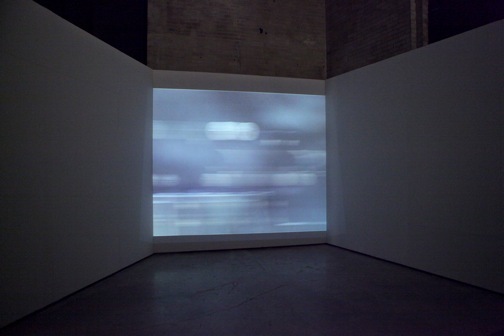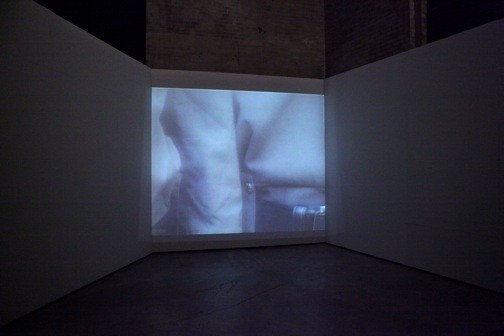Vancouver International Centre for Contemporary Asian Art
Finding Life & Humor in the World Around Us: Kan Xuan in Yellow Signal
By: Rachel Ozerkevich
Kan Xuan is one of the artists featured in Centre A’s current Exhibition, Yellow Signal: New Media in China. Xuan is a contemporary female artist working in a still male-dominated field, and her participation in the exhibition provides us with an exciting insight into her unique creative process and film projects. Currently on display in the gallery space are two of her poignant and humorous video pieces: One by One (2005) and Nothing! (2002). Through Xuan’s work, we are given brief glimpses into her exploration of the nature of image making and the possible failures of artistic representation.
Simply put, much of Xuan’s work explores the relationship between life and the world that surrounds us. Her videos are brief and simple, yet they allude to a deeper sense of spiritualism. The influence of Zen spirituality is often evident in her work. She has explored economics and politics as well: in her 2007 piece Island (2 yuan/1 Pound/1 Euro/1 Dollar), she depicted coins from various international currencies resting against objects. The piece was a reflection on the “vast economic and political changes that have affected every aspect of society” (Hou Hanru, “Paradigm Shifts”). Xuan’s seemingly simple footage and rough aesthetics forces the viewer to consider simple and often easily overlooked issues that bare significances in everyday life.
The Guangzhou Biennale catalogue of 2010 describes Xuan’s work as an exploration of the “cognitive dissonance between the seen and the known, between representation and reality”. This “dissonance” that the viewer experiences is precisely the point. For Xuan, the nature of image making—itself inherently problematic and full of inconsistencies—is a central aspect of her work. In an environment as politically charged and full of contradictions as modern-day China, her work is remarkable for its simplicity and honesty.
Xuan’s work plays an important role in Yellow Signal. The exhibition according to the curator and one of Centre A’s founding members Zheng Shengtian, is “a metaphor for the communal state of ambiguity in Asian countries…(it is) about limitation and possibility, choice and chance, confusion and self-confidence, feelings that many Asian artists experience, but that artists everywhere may also relate to in their creative practice”. Xuan’s work conveys these issues of ambiguity, dissonance and duality in a simple and universally relatable way.
One by One is a single channel video filmed with a rotating camera. The video captures a group of security guards under the sun in an unidentified urban setting. The spinning of the camera varies in speed, ranging from slow and steady to almost frantic. The result of immersing oneself in the projection room is varying degrees of dizziness. The camera jerks to a stop periodically to focus on aspects of the guards’ uniforms. The guards do not speak, though the viewer gets a sense of their environment from the sounds of the city: the birds, construction, pedestrians walking, car alarms, etc. The direct sunlight on the uniforms gives the scene a feeling of warmth. In short, the setting feels recognizable, normal and everyday.
The guards’ uniforms seem somewhat sinister. Since the viewer never sees anything above or below the lapel of the uniforms, the guards are faceless and dehumanized. One could easily overlook the fact that the guards are human if it weren’t for faint signs of movement and breath. The guards are interchangeable and seemingly permanent aspects of their environment. Many questions are invoked by experiencing this piece: who are these guards, and how are they interacting with their immediate surroundings? Since the uniformed torsos almost span the entire screen, they seem to define the surroundings, as they are the only beings visible. Do they control the environment? They certainly police it successfully by grabbing our immediate attention and making us dizzy.
One by One is very much indicative of Xuan’s desire to express a more direct understanding of life and illuminate commonly overlooked feelings of the everyday. The piece presents the mundane in an active and dizzying way. After mere seconds of viewing, one is overcome with the desire to see more of a recognizable urban scene. Even though we think we know what’s beyond the uniforms, we very much want to see for ourselves. The viewer is highly aware of having his or her gaze controlled and policed.
Nothing!, Xuan’s other work on display, is also a single channel video. In her brief description of the piece, she writes: “searching for it, crazy about it, and troubled by it, but ultimately, as we often see, there’s ‘nothing’”. The viewer is presented with shaky, frantic shots of the ground, leaves, holes and cracks in concrete and stone. Here, there are bugs, garbage and other debris. The narrating voice, distorted and manipulated to sound high-pitched and vaguely foreign, is clearly looking for something in a satirical and perhaps sarcastic way. The voice exclaims things like “Oh wow! Jeez! Jesus! Aaah! Shit! Ohhh!”. These exclamations are always followed by “Nothing!”
The result is a frenzied, hyperactive and very humorous look at the mundane, at the “nothing” that hides on the streets, in old concrete and in spaces that only insects inhabit. Really, there is always “something” in these spaces. The exclamation “nothing!” seems to belittle and discount the existence of what actually lies in these overlooked cracks. The implication is that bugs, garbage, rotting fruit and bizarre rock formations aren’t actually anything. The excited exclamations of “nothing!” suggest that this is exactly what the voice has been looking for. The mundane is made to be exciting, busy, blurred and worth commenting on. It’s everywhere! Go find it! This is what the voice seems to urge in its sarcastic, tongue-in-cheek way.
Nothing! seeks to explore the somewhat pointless nature of life for creatures who live close to the ground and who spend their energy following scents and trails. However, it invokes much more than pointlessness. The video’s humour and simplicity seem to urge the viewer to slow down and notice the seemingly insignificant, and often silly, aspects of everyday life. Both videos currently on display articulate this theme of the everyday presented under an inquisitive new lens.
Xuan’s participation in Yellow Signal is a unique opportunity to become acquainted with an important and noteworthy artist defying genre and subject matter boundaries in a politically charged climate. Her work is humorous and thought provoking. Her seemingly simple imagery makes for engaging experience that is in reality anything but simple. One comes away from viewing a Xuan video with a renewed curiosity, and perhaps even a criticality, for life’s little details.









